Tullyowen
Houses within 15km of this house
Displaying 51 houses.
Houses within 15km of Tullyowen
Displaying 51 houses.
| House name | Description | |
|---|---|---|
| Ashbrook | An early 18th century house, it was noted by Wilson as the seat of Mr. Moore in 1786. It was occupied by Michael Costello in 1814 and described as in a dilapidated state at the time of the first Ordnance Survey. The Irish Tourist Association file refers to a two-storey plain featured house with the ruins of a small private chapel closeby, which apparently fell into decay in the early 19th century. Some ruins remain at the site. | |
| Benada | The Jones had a house here in the eighteenth century as Wilson refers to Banada as the seat of Mr. Jones in 1786. It was held in fee by Rev. Daniel Jones at the time of Griffith's Valuation when it was valued at £17. In 1858 it was transferred to the Sisters of Charity who ran a girls' school and orphanage there. In the twentieth century it became a secondary school and continued in that role until 2004 when it was sold to a private developer. |

|
| Cloonbarry | At the time of Griffith's Valuation Cloonbarry was occupied by George Knox and was valued at £27.It was offered for sale in July 1866 by Roger Dodwell Robinson, when it was described as "an excellent dwelling house, erected by the owner's father at an expense of £2000". In 1906 Henry McCarrick was the owner of buildings at Cloonbarry, barony of Leyny, valued at £22. McTernan states that it had fallen into disrepair by the 1950s and was subsequently demolished. | |
| Gleneask Lodge & Cottage | At the time of Griffith's Valuation, John Brett was leasing over 500 acres and a herd's house valued at £4, from John Taaffe, at Tullaghaglas, barony of Leyny. Lewis records Glenesk, in Kilmacteige parish, as a seat of the Taaffe family, in 1837. This is Gleneask Cottage, still extant and occupied. McTernan indicates that this property was built by the Irish Waste Lands Improvement Society, when they leased the Taaffe estate in the 1830s. In 1866, when the property was offered for sale, "Gleneask House" was described as being situated in "most romantic scenery". McTernan writes that this latter property was a hunting lodge built by the Taaffes in the 1850s and demolished in the 1930s | |
| Carrowgowan | From at least 1814 the house was occupied by the Deanes who held it from Colonel McAlpine, who held from John Knox of Castlereagh. The house was described as in good repair, with offices, orchard and garden. Daniel H. Mellet occupied the house at the time of Griffith's Valuation. It is now demolished. | |
| Oldcastle | Built by the McJordans of Ballylahan in the late 18th century. Slater refers to it as the seat of John Bolingbroke in 1846. There are modern buildings at the site now. |

|
| Brabazon Park | Built by George Brabazon in 1777. In 1786 Wilson refers to it as "the fine seat of George Brabazon with beautiful demesnes".Slater refers to it as the seat of George Rutledge in 1846. It was held in fee by Captain Hugh Brabazon at the time of Griffith's Valuation, when it was valued at £30. Sold by the Congested District Board to the Sisters of Mercy circa 1920s, who ran a domestic economy school there for many years. It was demolished in the later twentieth century to make way for the building of a health care facility. Part of the demesne is now Swinford Golf Course and Community Sports Facility. |
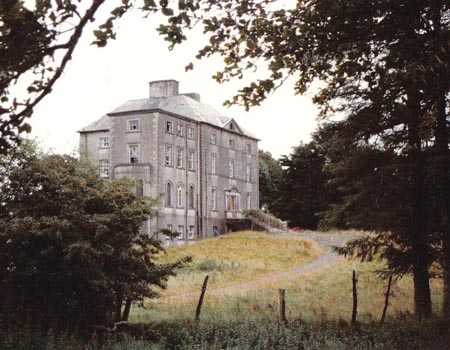
|
| Oatlands House | The residence of the O'Dowds of Bunnyconnellan until the sale of their estate in 1854 when it was bought by Charles Downing and leased to Henry McLoghry. At the time of Griffith's Valuation Downing held it in fee when it was valued at £10. It is labelled Bunnyconnellan Cottage on the 1st edition Ordnance Survey Map but as Oatlands House on the 25-inch edition of the 1890s. This is the name by which it is still known. The Irish Tourist Association file refers to Oaklands House owned by Mr McAndrew in which some of the old O'Dowd house was probably incorporated. The house has been restored and in 2015 was offered for sale. | |
| Dove Hall | This house is labelled Dove Hall on the 1st edition Ordnance Survey map. A larger house, named Belgarrow House, is shown at the site on the 25-inch edition of the 1890s. It was occupied by Courtney Strogen and his descendants during the 19th century, held on lease from the Evans family. Occupied by John A. Knox in 1906. Belgarrow is now a ruin. | |
| Midfield House | Occupied by Anthony Kelly in 1814 and by P. Kelly in 1837. There is no house with a significant valuation in this townland at the time of Griffith's Valuation. Farm buildings appear to occupy the site now. | |
| Longfield House | Occupied by Colonel Kelly in 1814 and by Mrs Kelly in the 1830s. A house valued at £4 in this townland in the 1850s was occupied by Andrew Walsh. It is now a ruin. | |
| Glencarha | The Ordnance Survey Names Books record that the house was 'a new edifice not yet finished', the intended residence of George Fenton, an attorney of Kilglass, near Ballina, who was leasing the townland. The house was occupied by Isaac McLoghry at the time of Griffith's Valuation. Buildings are still extant at the site. | |
| Barleyhill | In 1786 Wilson noted Barleyhill as the seat of Mr. McManus. Ruane dates the house from about 1748 with alterations in the 1770s and 1790s. He states that the house and 170 acres were occupied by George Harkin at the time of Griffith's Valuation, however the Valuation records Bernard McManus as the occupier of the house valued at £15. Quinn records that Bernard McManus had gone to live at Brownstown in 1856. The Aitken family have lived at Barleyhill for over a hundred years. |
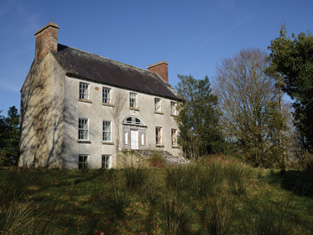
|
| Moorbrook | In 1786 Wilson refers to "Moore-field" as the seat of Mr. Moore. Leet's Directory records 'Moorfield' as an 'unoccupied seat' in 1814. The house appears, however, to have become known as Moorbrook as it is thus labelled on the Ordnance Survey maps. Henry Wills held Moorbrook at the time of the sale in 1854. At the time of Griffith's Valuation, it is described as a "herd's house" and occupied by Francis O'Grady. It is labelled as "in ruins" on the 25-inch Ordnance survey map of the 1890s. A modern house has been constructed near the site. | |
| Cloongee | Originally a Moore home which was sold by Harloe Phibbs Baker to the McDermotts who lived there until the 20th century. At the time of Griffith's Valuation it was held in fee by Owen McDermott and valued at £7. The National Inventory of Architectural Heritage notes Cloongee as a rare survivor of a late-seventeenth century house in county Mayo. It is still extant and occupied. |

|
| Newcastle | Newcastle was the home of Andrew Clarke O'Malley, son of George O'Malley of Spencer Park. Following the death of Andrew's son, Owen Bingham Manners O'Malley, in 1886, Newcastle became the property of his sister, Elizabeth Brewster. Count Manus O'Donel, a Major General in the Austrian Service, lived at Newcastle in the late 18th century. In 1786 Wilson refers to it as the seat of General O'Donnell. Occupied by David Ruttledge in 1814 and by Jacob Beckett at the beginning of the 20th century. Only a portion of the original building is now extant. |

|
| Bunnacranagh House | Luke Colleran was leasing a property valued at £12 at Bunnacrannagh, barony of Leyny, from the Knox estate at the time of Griffith's Valuation. This house was built after the publication of the 1st edition Ordnance Survey map. It is labelled Bunnnacranagh House on the 25-inch edition of the 1890s. In the twentieth century part of this premises served as the post office for the village of Curry nearby. There is still an extant house at this site together with other remains of estate architecture. Part of the property was offered for sale in 2007. |

|
| Mullaghawny | Charles 'Sturgeon' (Strogen) was resident at Mullaghawny when Leet's Directory was compiled in 1814 and the Ordnance Survey Name Books refer to the dilapidated state of a mansion house in the townland of Mullaghawny belonging to Charles Strogen. Only a small portion of the buildings are visible on the 25-inch Ordnance Survey map of the 1890s. | |
| Sallymount | Home of Lewis Atkinson in the early 19th century. At the time of Griffith's Valuation the house was leased by Edward Atkinson from the Wingfield estate when it was valued at £4. The site is now occupied by farm buildings. | |
| Quignashee | Edward Howley occupied a property valued at £5 at Quignashee, barony of Tireragh, as well as 300 acres, at the time of Griffith's Valuation. Since 1898 this townland has been located in county Mayo. A building remains at the site. | |
| Rahans | The home of the Atkinson family, Wilson notes in 1786 that it was the residence of Charles Atkinson and "very pleasantly situated". It was occupied by the rector of Crossmolina, the Reverend Edwin Stock, for a few years prior to 1815. Rahans was described in 1855 as "a comfortable dwelling house, in a fair state of repair" and occupied by Mrs Frances Atkinson. At the time of Griffith's Valuation it was the home of George Orme. In 1925 Adelaide R. Orme of New South Wales sold Rahans demesne to Patrick J. Ruttledge of Ballina for £3,000, [see Acc. 1165/8/11 National Archives.] It is no longer extant. | |
| Ardnaree Rectory | At the time of Griffith's Valuation Rev. Joseph Verscoyle was occupying the house at Glebe, parish of Kilmoremoy, valued at £30. This house is no longer extant. | |
| Downhill | The house at Downhill is recorded as being built by Mr. Brennan, Merchant, Ballina. It appears, from the Ordnance Survey Name Books, that the townland of Knockalyre or Downhill was part of the Gore estate in 1836. Dr. McHugh of Ballina also had an interest in the property which he was renting to Rev. Thomas Feeney in 1857. Colonel Knox Gore also had a mill complex in this townland which, at the time of Griffith's Valuation, he was leasing to William Symes. Downhill House became a hotel when it was purchased by the Moylett family in 1936. |

|
| Ardnaree Cottage | Ardnaree Cottage dates to at least the early eighteenth century and possibly earlier. It was part of the Gore estate. Wilson, writing in 1786, refers to "Mr. Jones' charming demesne". In 1837 it was the residence of Thomas Jones and in 1857 it was leased by Col Arthur Knox Gore to Anne Hearne when it was valued at £10. The National Inventory of Architectural Heritage notes it as an important component of the domestic built heritage of Ballina. It is still extant and well-maintained. |

|
| Ballylahan | A property held by Pat McLaughlin from Sir William H Palmer in the early 19th century and by the Atkinsons at the time of Griffith's Valuation. Quinn writes that it was repossessed at the time of the expiration of their lease. It was a ruin by the publication of the 25-inch Ordnance Survey map of the 1890s. | |
| Belleek Castle/Ballina House | Edward J Howley held Belleek Castle and demesne on a lease originally granted by James O'Hara 2nd Lord Tyrawley to Vaughan Jones for 999 years, dated 25 Mar 1739. He was residing at Belleek in the 1830s. The Castle was leased to the Pery family in the late 1860s. It is now known as Ballina House. |

|
| Beaufield House | "Bowfield" House was occupied by E. Howley in the 1830s. On both the 1st and 25-inch editions of the Ordnance Survey maps the house is labelled Beaufield House. No house of more that £1 valuation was recorded in the townland of Carrowcastle at the time of Griffith's Valuation. It is no longer extant. | |
| Ellaghmore | Occupied by Edmund Howley in 1814 and by E. Howley in the 1830s. A house valued at £2.10 shillings was occupied by Bartholomew Higgins at the time of Griffith's Valuation. It is no longer extant. | |
| Mount Falcon | A lodge and offices were built in 1826. In 1876 the building of Mount Falcon Castle was completed. Bought by the Aldridges in 1932 the Castle was run as a country guest house in the latter part of the 20th century. Following the death of Mrs Aldridge in 2003 the property was bought by the Maloney brothers and is now run as a luxury hotel. See www.mountfalcon.com |

|
| Carns Lodge | In 1906 Lord Harlech's estate was the owner of buildings valued at £18 at Carns, parish of Kilmacteige. . McTernan notes the house as Carns Lodge, which he says was built in the late 1850s as a gamekeeper's house. It is still extant and occupied. | |
| Rinagry Cottage/Rinagry House | The residence of a junior branch of the Gortnaraby family, described at the time of the first Ordnance Survey as "a neat thatched cottage built in 1807". Rinagry was leased by Edward S. Perry from John Ormsby at the time of Griffith's Valuation, when it was valued at more than £10. An enlarged building is labelled Rinagry House on the 25-inch Ordnance Survey map of the 1890s. It is no longer extant. | |
| Coolcronaun | Coolcronan House was built by Edmond Pery at the time of his marriage to Sarah Jane Knox Gore in the mid-nineteenth century. The family owned the property until the 1950s. The Irish Tourist Association File states that it was erected in 1860 by the Knox Gores. It was extensively renovated in the late 1990s and is still extant and available as holiday accommodation. See http://www.coolcronan.com. |

|
| Woodbine | A house belonging to the Gores, Earls of Arran, which was the residence of the Ham family until the 1860s, one of whom built the Upper Bridge over the River Moy in Ballina. The Hams subleased from the Jones family. The house was bought by Anne Elizabeth Jones in the early 1870s in trust for her son Henry Hastings Jones. The Jones family sold Woodbine to an American lady in 1939. It was offered for sale again in recent years. |
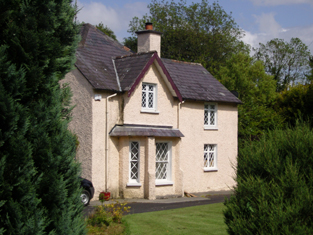
|
| Creggagh | The house valued at £6 was held by John Fair at the time of Griffith's Valuation but was unoccupied. In 1894 Slater noted it as the seat of Major D.R. Fair. It was occupied in the early decades of the twentieth century but is now a ruin surrounded by forestry. |

|
| Liscottle | Home of the Horkan family in the second half of the 19th century. It was leased by George "Harkan" from Robert Ruttledge at the time of Griffith's Valuation when the house was valued at £2. It is labelled Liscottle House on the 25-inch Ordnance Survey map of the 1890s. Liscottle is no longer extant. | |
| Quignalecka | At the time of Griffith's Valuation Rev. James Lindsay was leasing a property valued at £5 at Quignalecka, to Capt. William Wright. Since 1898 this townland has been part of county Mayo. | |
| Drummartin | At the time of Griffith's Valuation, Drummartin House was being leased by Joseph McCarthy, MD, from Caleb Digby. It was valued at £12. In the 1870s it is recorded as the address of Mrs. Mullarkey. The sale notice of June 1885 indicates that it was a modern house erected at a cost of over £2000 and the main tenant was William Evans. | |
| Carns (Kilmacteige) | At the time of Griffith's Valuation, Henry McCarrick was leasing a property valued at £14 in the village of Aclare (Carns townland), from the estate of William Evans. A shooting lodge is marked in this townland on the 25-inch Ordnance Survey map of the 1890s. | |
| Rathmagurry House | The 1st edition OS map indicates Rathmagurry House at Rathmagurry in Achonry Parish. At the time of Griffith's Valuation William Gawley was leasing a herd's house valued at £2 from the Knox estate at this location. The house is no longer extant. | |
| Coolaghy Lower | Reverend George Hanson was leasing this property from the Abercorn estate at the time of Griffiths Valuation in the 1850s, when it was valued at £12. A substantial farm exists at the site. | |
| Galdonagh Upper | Charles Watson was leasing this property from the Abercorn estate at the time of Griffiths Valuation in the 1850s, when it was valued at £12. A hose and farm buildings are still extant at the site. | |
| Tullyrap | Alexander Finlay was leasing this property from the Abercorn estate at the time of Griffiths Valuation in the 1850s, when it was valued at £25 and had an adjacent mill. A substantial farm still occupies the site. | |
| Foyle View | Alexander Porter was leasing this property from the Abercorn estate at the time of Griffiths Valuation in the 1850s, when it was valued at £10. A farm still exists at the site. | |
| Whitehill (Raphoe North) | James Browne was leasing this property from the Abercorn estate at the time of Griffiths Valuation in the 1850s, when it was valued at £11. A house is still extant at the site. | |
| Drumenan | James Alexander was leasing this property from the Abercorn estate at the time of Griffiths Valuation in the 1850s, when it was valued at £12. A house and farm are still extant at the site. | |
| Ardagh (Raphoe North) | Andrew Rolleston was leasing this property from the Abercorn estate at the time of Griffiths Valuation in the 1850s, when it was valued at £11. | |
| Raphoe Bishop's Palace | William Ker was leasing this property from the Ecclesiastical Commissioners estate at the time of Griffiths Valuation in the 1850s, when the buildings were valued at £45. The Bishop's Palace was destroyed by fire in 1838 and has remained a ruin ever since. |
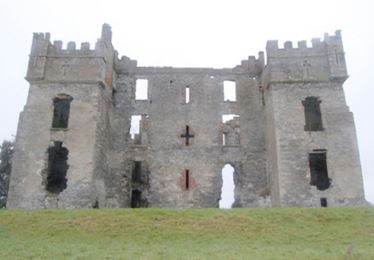
|
| Drumineney | David Wilson was leasing this property from the Ecclesiastical Commissioners estate at the time of Griffiths Valuation in the 1850s, when it was valued at £16. The National Inventory of Architectural Heritage suggests that the current house at this site was developed c.1870 from an earlier building. Robert Wilson was also leasing property in this townland at the same time. A house and extensive farm exist at the site. | |
| Tops (Raphoe) | John Wilson was leasing this property from the Ecclesiastical Commissioners estate at the time of Griffiths Valuation in the 1850s, when it was valued at £18. The National Inventory of Architectural Heritage suggests the current house was built c.1852 possibly on the site of an earlier house. Eliza Wilson was also leasing property at this location in the 1850s. |
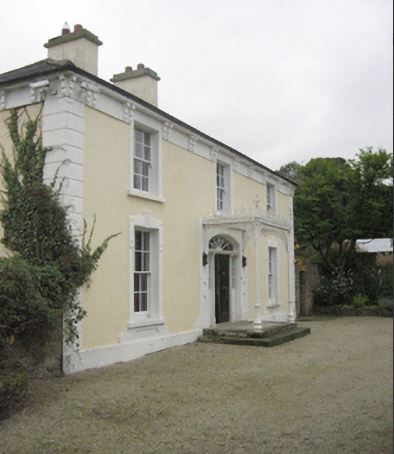
|
| Coolaghy (Raphoe) | William Hamilton was leasing this property from Reverend Lord Edward Chichester's estate at the time of Griffiths Valuation in the 1850s, when it was valued at £20. It appears to have been associated with the Hamilton family for much of the nineteenth and early twentieth centuries. It is still extant and occupied. |
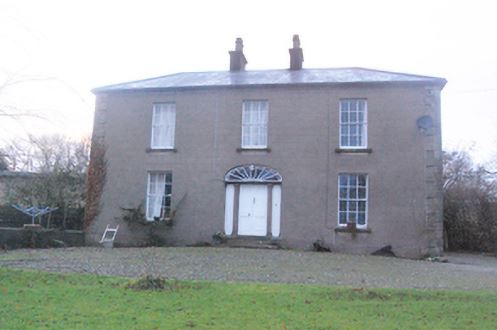
|
| Altaskin Lodge | Robert Rankin was leasing this property from the Ecclesiastical Commissioners estate at the time of Griffiths Valuation in the 1850s, when it was valued at £16. |

